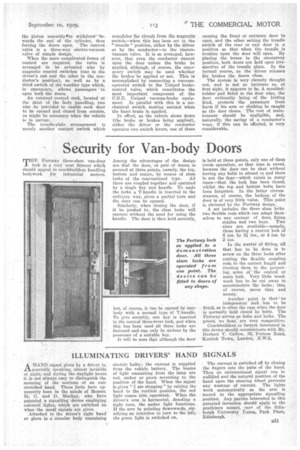REMOTE CONTROL FOR BUS DOORS
Page 56

Page 57

If you've noticed an error in this article please click here to report it so we can fix it.
The National-Pneumatic-Peters System of Remote and Automatic Control for Doors, which is on Exhibition at Yarmouth This Week.
ON another page of this issue we have described the Uniped vacuumbrake equipment for heavy commercial %chicks, which has just become available and will be shown at the conference of the Municipal Tramways and Transport Association at Great Yarmouth this week.
G. D. Peters and Co., 'Ltd., of Caxton House, Westminster, London, and Slough, Bucks, which is associated with the Consolidated Brake
and Equipment Ca., Ltd., is demonstrating at the Yarmouth Conference, on the A.E.C. Reliance coach which is used for showing the brake. equipment, the latest form of its ingenious' arrangemeats for the control of •motorbus doors.
Our readers in London Will be familiar With the pneumatically operated automatic doors in 'use on the 'Underground Railway ; these are Inlaid 21C
1330
tured by G. D. Peters and Co., Ltd., and, fundamentally, are of similar design to the bus-door-operating, gear., The demonstration coach which is available for municipal engineers at Yarmouth this week is equipped in the very fullest manner, and it is possible that those inspecting it may be inclined to regard the arrangement as unnecessarily complicated. We would point out, however, that only in extraordinary cases would it be necessary
for both front and rear doors to be operable by both driver and conductor, one of them being arranged to open automatically when a passenger approaches it from the interior, and for emergency control from inside and outside the vehicle to be incorporated.
• In its simplest form the equipment consists of a vacuum reservoir, a -simPle pisten-type door engine, an eloctro-vacuum control valve, a simple Remote control of this valve, which governs the door engine, is effected magnetically.
• . .
-form of tumbler switch and a small ,non-return. vacnum-feed. valve. With
.these..ti7e, units, the cost of which would be round about £20, it is possible for a -bus operated by one than to be -ecivipped so that the ,driver can open 'and close the doors at will, simply by using a switch placed close at hand.
,It beunderstood that • the 'door is opened and closed by the sliding of a pneumatically operated piston, the introduction of electricity being only necessary to provide, remote control. Air is drawn from the reservoir through the non-return 'valve by the suction in the induction pipe of the engine. • The reser% oir is connected permanently by a pipe to an annular space in the door engine surrounding the piston assembly.When -the doors are closed the space above the piston head is also exhausted, and atmospheric pressure, therefore, causes the .piston to remain as far, in the cylinder as possible. To open the doors air is
• allow,ed into the cylinder head by means of the • contrel valve, when of course, the vacuum in the annular space causes
the Piston assemblyvto withdraw'"towards the end of the cylinder, thus forcing the doors open. The control valve is a three-way electro-vacuum valve of simple design.
When the more complicated forms of control are required, the valve is arranged to he actuated also by magnetic control switches (one in the driver's cab and the other in the con-. ductor's position), as well as by a third switch of the tumbler type which, in emergency, allows passengers ' to open both the doors.
An external control cock, located at the skirt of the body panelling, can also be provided to enable each door to be opened and closed from outside, as might be necessary when the vehicle is in garage.
The treadle-plate arrangement is merely another contact switch which completes the circuit from the magnetic switch—when this has been set in the " treadle" position, either by the driver or by the conductor—to the electro, vacuum valve. It is so arranged, however, that even the conductor cannot open the door unless the brake be applied, although, of course, the emergency switch may be used whether the brakes 'be applied or not. This is accomplished by connecting a vacuumoperated switch to the TJniped brakecontrol valve, which constitutes the most important component of the C.B.E. Uniped vacuum-brake equipment. In parallel with this is a mechanical switch making contact when the hand brake is applied.
In effect, as the vehicle slows down '(the brake or brakes being applied), either the driver or the conductor operates two switch levers, one of these causing the front or entrance door to open, and the other setting the treadle switch of the rear or exit door in a position so that when the treadle is trodden upon the door will open. By placing the levers in the emergency position, both doors are held open irrespective of the treadle plate. In the normal course, as the driver releases his brakes the doors dose.
The system is very cleverly thought out, and is not so intricate as, at first sight, it appears to be. A mouldedrubber pad fitted to the door edge, the door ordinarily being of the folding kind, protects the passenger from harm if his arm or clothing be caught as the door closes. The cost of maintenance should be negligible, and, naturally, the saving of a conductor's wage, if this can be effected, is very considerable.




















































































































